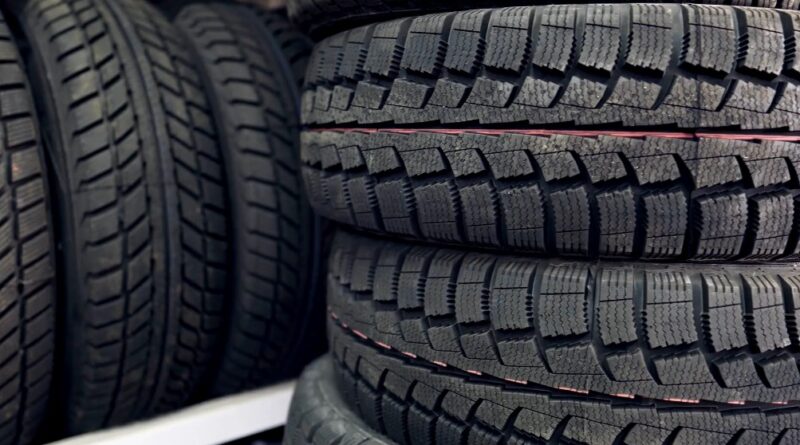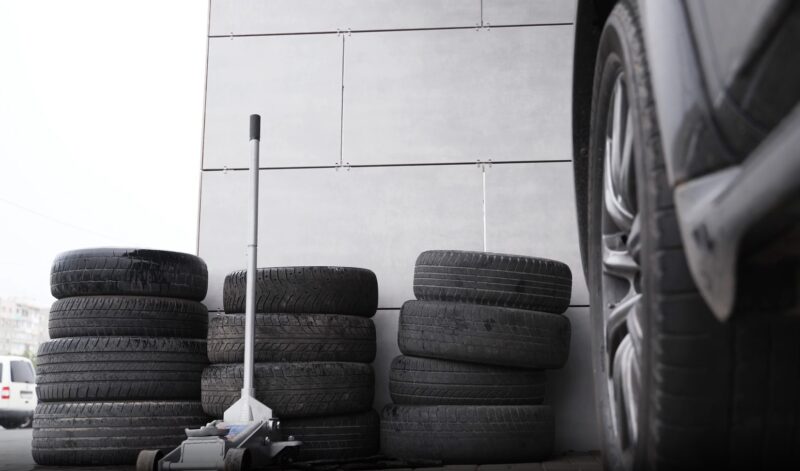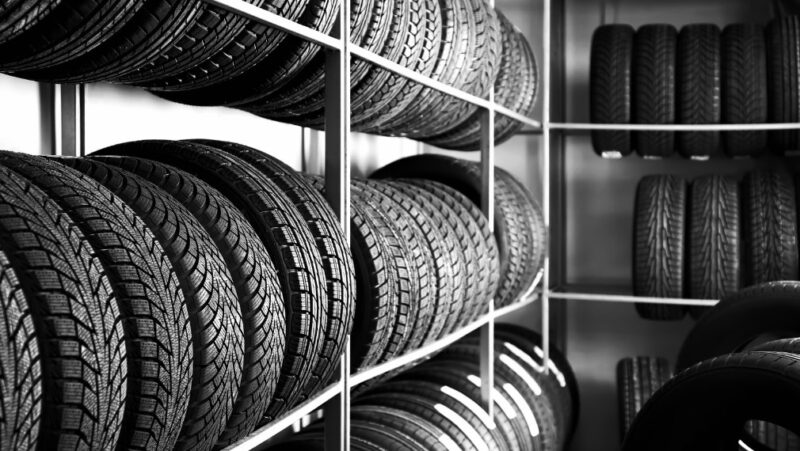Storing tires correctly in the garage is key to prolonging their lifespan. I’ve come to realize that tires require special care when not in use to prevent them from aging prematurely.
By storing them correctly, we can extend their life, which ultimately helps me save money. While there are only a handful of options when it comes to storing, there are numerous factors that can be included in the whole process.
Today, I will address several things, like:
- Various storage methods such as stacking tires flat, hanging them vertically, and using wall-mounted or overhead racks.
- Recognizing the difference between P-metric (passenger vehicle) and LT-metric (light truck) tires is important.
- Cleaning the tires thoroughly using a brush, soap, and water is essential.
- The storage area should be cool, dry, and away from direct sunlight and ozone sources.
- Keeping tires inflated to the manufacturer’s recommended pressure even during storage is crucial for maintaining their shape and preventing sidewall damage.
Buckle up and let us begin.
Choosing the Right Storage Method

To effectively store tires in your garage, assess the space available and the type of tires you have.
- Stacking Tires Flat: If these are mounted on rims, one efficient option is to stack them horizontally. This method is space-saving and keeps them easily accessible.
- Hanging Tires Vertically: Another method for tires on rims is to hang them vertically using hooks. It is a space-efficient solution.
- Wall-Mounted Tire Racks: For a more organized approach, wall-mounted tire racks are an excellent choice.
- Overhead Racks: In garages where floor space is limited, overhead racks present an innovative solution.
Identifying the Need for Storage

Home tire storage is a crucial aspect for various individuals, including those passionate about racing, car enthusiasts who enjoy DIY projects, and individuals who require different tires for different seasons.
A fundamental aspect of effective tire storage is understanding the distinction between two primary types of tires:
- P-metric
- LT-metric
P-metric are designed primarily for passenger vehicles. These are known for providing a smoother and more comfortable ride, making them ideal for family cars and everyday use. In contrast, LT-metric are tailored for light trucks.
These tires are typically heavier and noisier compared to P-metric, but they offer deeper treads, which are essential for the kind of heavy-duty use that light trucks often endure. Recognizing the type of tire you own is crucial in determining the most suitable method for storing them.
For instance, the softer tires of a family car might require different storage conditions compared to the more rugged and durable tires used on light trucks. When stored correctly, they maintain their quality and performance characteristics, ensuring that they are ready for use when needed.
This is particularly important for those who switch tires based on the season or for specific purposes, such as racing or off-road adventures.
Preparing Tires for Storage

The process of preparing tires for storage is an integral part of the maintenance, crucial for extending their lifespan and ensuring they remain in optimal condition. The first and perhaps most important step in this process is cleaning the tires.
Over time, they accumulate a variety of contaminants such as dirt, brake dust, and road grime. These substances, if not properly removed, can lead to the deterioration of the tire’s rubber, reducing its longevity and effectiveness.
The Cleaning Process

To effectively clean the tires, you should use a brush, which is specifically designed to handle the robust texture of rubber. Along with the brush, a mixture of mild soap and water should be used to scrub them thoroughly.
This cleaning process helps in removing all the accumulated dirt and grime, ensuring that the tires are completely clean. Once they are washed, it is equally important to dry them completely. Any residual moisture left on the tires can lead to issues such as mold or mildew growth, which can damage the rubber.
Therefore, after washing, they should be wiped down with a clean, dry cloth and left to air dry until there is no remaining moisture.
Using Airtight Plastic Bags
An additional step in the tire storage process is to place the tires in airtight plastic bags. This method is highly effective in protecting them from exposure to moisture and air, both of which can cause rubber degradation over time.
By sealing them in these bags, you create a barrier that maintains the tire’s condition, preventing the rubber from drying out or cracking. The packing process, though simple, plays a crucial role in maintenance. It ensures that they are kept in a state that preserves their functionality.
Tips for Effective Tire Storage
When it comes to tire storage, the environment plays a crucial role. But it is not the only one.
Choose the Right Environment
Ensure that the storage area is cool and dry, shielded from direct sunlight and far from ozone-generating sources such as electric motors or furnaces. This environment is critical as it protects tires from the damaging effects of UV rays and prevents deterioration caused by extreme temperature fluctuations.
Store Tires Vertically If Not on Rims

For tires that aren’t mounted on rims, vertical storage is ideal. This position reduces the pressure on any single point. Periodically rotating them while in storage can further help in evenly distributing any weight or stress, preventing them from losing their shape or developing flat spots.
Maintain Proper Air Pressure
Keep the tires inflated to the manufacturer’s recommended air pressure, even during storage. This helps in maintaining their shape and prevents the sidewalls from becoming weak or cracking over time. Regularly check the air pressure to ensure it stays at the optimal level.
Avoid Exposure to Chemicals
Store tires away from chemicals, solvents, or hydrocarbons that could degrade the rubber. Exposure to these substances can accelerate the aging process of tires, making them brittle and less effective.
Use Covers
Consider using tire covers for additional protection, especially if storing tires outside or in an area exposed to elements. These covers can shield them from dirt, moisture, and direct sunlight, further extending their lifespan.
Keep the Storage Area Clean
Ensure the area where you store your tires is clean and free from sharp objects or debris. A clean storage space reduces the risk being punctured, scratched, or damaged in any other way.
Maintaining Garage Organization

Maintaining an organized garage is essential, especially when it involves storing specific items like tires. Allocating a dedicated area for this purpose not only conserves valuable floor space but also enhances the overall neatness and orderliness of the space.
This task is about seamlessly incorporating such storage into your broader garage organization strategy. One effective way to achieve this is by making good use of vertical space. Options like wall-mounted or overhead racks are particularly beneficial in garages that are compact or have limited available area.
These storage solutions elevate items off the ground, freeing up floor space for other uses or simply for easier maneuverability within the garage. By efficiently using the space you already have, you can avoid the additional costs and inconvenience associated with storing items at a separate location.
FAQs
Should tires be stored on concrete?
It’s not recommended to store tires directly on concrete. Placing a barrier like cardboard or wood between the tires and concrete is advised to prevent moisture absorption and protect the rubber.
Do tires go bad if they sit?
Yes, tires can degrade over time even if they sit unused. Factors like temperature, sunlight, and humidity can contribute to the aging process.
How long can tires sit unused on a car?
Tires sitting unused on a car for extended periods (typically over 6 months) can develop flat spots and age prematurely, affecting their performance and safety.
Can I use 10-year-old tires?
It’s not recommended to use 10-year-old tires. Even if they appear in good condition, the rubber compounds can deteriorate over time, potentially leading to safety issues.
In Summation
Storing my tires properly has become a vital part of my tire maintenance routine and garage organization.
By recognizing the specific needs of different types and using efficient storage methods, I’ve been able to extend their lifespan while keeping my garage space well-organized.
Make sure to clean and pack them correctly, and be careful to store them in an environment that’s conducive to their preservation. I am confident this insight of mine will be of much help in your future strivings.
